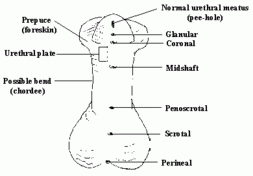Hypospadias is a condition in which the urethra does not develop the right way and the urethral opening (meatus or pee-hole) is not in the normal place at the tip of the penis. The opening can occur anywhere below the tip of the penis, along the shaft of the penis, or all the way to the scrotum.
Hypospadias is one of the most common problems that boys are born with. It happens in one of 250 to 300 male births.
There is no one cause for hypospadias. It is known to run in families. If a father has a hypospadias, there is chance a son will also have it.
How do you know your child has hypospadias?
Usually during the child's newborn exam, the doctor will note that the opening or urethral meatus is not at the tip of the penis. In addition, the penis may also have a forward bend to it that is called chordee. Lastly, the foreskin is usually not completely developed ("dorsal hooded" foreskin). The child should not be circumcised because the foreskin is often needed later for the surgical repair.
Does hypospadias always need to be repaired?
Most often surgery is needed except in very minor cases of hypospadias. The reason a hypospadias needs to be repaired is to make the penis look and function as normally as possible. After the surgery, the penis will look circumcised. The surgery also allows the boy to have a normal urinary stream and urinate in a standing position.
When should the surgery be done?
Generally, sometime between 4 and 14 months of age. Boys become aware of the penis around 14 to 18 months of age, so if the surgery is done before this age, they will not remember it. At this age, the risks of anesthesia are similar to those of an older child or adult.
How is the hypospadias repaired?
Several different types of surgeries are possible. The position of the opening will determine what type of surgery is needed. Your surgeon will suggest the best procedure for your child.
What are the risks and complications of the surgery?
The most common complications include the development of either a fistula (leak) or a stricture (scar tissue causing narrowing of the channel). A fistula is often found if two separate urine streams are seen when the child urinates. This is because the surgery requires many sutures to join the tissues, so a small leak can occur at the incision site. If the fistula does not close on its own, a second repair surgery will be needed about six months after the first repair. A stricture, may also occur at any time after hypospadias repair and may require a second procedure to repair it.
The more severe the hypospadias, the higher the chances of complications. In very rare instances, the tissue doesn't heal and the surgery needs to be redone. However, the overall success rate is about 90 to 95% for most hypospadias surgery.
Page reviewed on: Apr 29, 2009
Page reviewed by: Leslie T. McQuiston, MD
